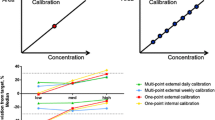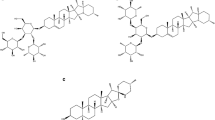Abstract
A liquid chromatography-tandem mass spectrometric (LC–MS/MS) method was developed and validated for the analysis of seven common sartans (candesartan, eprosartan, losartan, olmesartan, telmisartan, valsartan, and losartan carboxylic acid (EXP3174), the active metabolite of losartan) in postmortem blood samples with liquid–liquid extraction. Detection was accomplished by triple-quadrupole MS in the selected reaction monitoring mode. The validation procedure showed low limits of quantitation of 5 ng/mL for all compounds with good accuracy and precision. The matrix effect was evaluated from the variation of peak areas and concentrations. The method shows some matrix effect but the effect was efficiently compensated by using an internal standard method. The method was applied to the analysis of sartans in postmortem blood samples, and produced 534 positive findings during 2014–2015. Nine deaths were encountered where the concentration of a sartan was very high, indicating intoxication together with other causes of death or multi-drug intoxication. The quantitative results indicate that sartans do not show significant postmortem redistribution; thus concentrations higher than the therapeutic range can be considered as being toxic or fatal.

Similar content being viewed by others
References
Ryan MR, Didion SP, Mathur S, Faraci FM, Sigmund CD (2004) Angiotensin II-induced vascular dysfunction is mediated by the AT1A receptor in mice. Hypertension 43:1074–1079
Sharma AM, Janke J, Gorzelniak K, Engeli S, Luft FC (2002) Angiotensin blockade prevents type 2 diabetes by formation of fat cells. Hypertension 40:609–611
Ahmad S (1996) Losartan and reversible psychosis. Cardiology 87:569–570
Bosch X (1997) Losartan-induced hepatotoxicity. J Am Med Assoc 278:1572
Celentano C, Prefumo F, di Vera E, Iannicco A, Pio Gallo D, Liberati M (2008) Reversible acute fetal renal failure due to maternal exposure to angiotensin receptor blocker. Pediatr Nephrol 23:333–334
Forrester MB (2007) Valsartan ingestions among adults reported to Texas Poison Control Centers, 2000–2005. J Med Toxicol 3:157–163
Jang DH, Nelson LS, Hoffman RS (2011) Use of naloxone and vasopressin to treat prolonged hypotension following valsartan overdose. Abstracts of the 2011 International Congress of the European Association of Poisons Centres and Clinical Toxicologists, 24–27 May 2011, Dubrovnik, Croatia. Clin Toxicol 49:209
Baffoni L, Durante V (2004) Acute pancreatitis induced by telmisartan overdose. Ann Pharmacother 38:1088
Muszalska I, Sobczak A, Dołhań A, Jelińska A (2014) Analysis of sartans: a review. J Pharm Sci 103:2–28
González L, Alonso RM, Jiménez RM (2000) A high-performance liquid chromatographic method for screening angiotensin II receptor antagonists in human urine. Chromatographia 52:735–740
González L, López JA, Alonso RM, Jiménez RM (2002) Fast screening method for the determination of angiotensin II receptor antagonists in human plasma by high-performance liquid chromatography with fluorimetric detection. J Chromatogr A 949:49–60
Gonzalez O, Alonso RM, Ferreirós N, Weinmann W, Zimmermann R, Dresen S (2011) Development of an LC–MS/MS method for the quantitation of 55 compounds prescribed in combined cardiovascular therapy. J Chromatogr B 879:243–252
Nie J, Zhang M, Fan Y, Wen Y, Xiang B, Feng TQ (2005) Biocompatible in-tube solid-phase microextraction coupled to HPLC for the determination of angiotensin II receptor antagonists in human plasma and urine. J Chromatogr B 828:62–69
Ferreirós N, Iriarte G, Alonso RM, Jiménez RM (2007) Development of a solid phase extraction procedure for HPLC–DAD determination of several angiotensin II receptor antagonists in human urine using mixture design. Talanta 73:748–775
Ferreirós N, Dresen S, Alonso RM, Weinmann W (2007) Validated quantitation of angiotensin II receptor antagonists (ARA-II) in human plasma by liquid-chromatography–tandem mass spectrometry using minimum sample clean-up and investigation of ion suppression. Ther Drug Monit 29:824–834
Ferreirós N, Iriarte G, Alonso RM, Jiménez RM, Ortíz E (2008) Separation and quantitation of several angiotensin II receptor antagonist drugs in human urine by a SPE–HPLC–DAD method. J Sep Sci 31:667–676
Brunetto MR, Contreras Y, Clavijo S, Torres D, Delgado Y, Ovalles F, Ayala C, Gallignani M, Estela JM, Martin VC (2009) Determination of losartan, telmisartan, and valsartan by direct injection of human urine into a column-switching liquid chromatographic system with fluorescence detection. J Pharm Biomed Anal 50:194–199
Kristoffersen L, Øiestad EL, Opdal MS, Krogh M, Lundanes E, Christophersen AS (2007) Simultaneous determination of 6 beta-blockers, 3 calcium-channel antagonists, 4 angiotensin-II antagonists and 1 antiarrhytmic drug in post-mortem whole blood by automated solid phase extraction and liquid chromatography mass spectrometry: method development and robustness testing by experimental design. J Chromatogr B 850:147–160
Gergov M, Nenonen T, Ojanperä I, Ketola RA (2015) Compensation of matrix effects in a standard addition method for metformin in postmortem blood using liquid chromatography–electrospray–tandem mass spectrometry. J Anal Toxicol 39:359–364
Baselt BC (2014) Disposition of toxic drugs and chemicals in man, 10th edn. Biomedical Publications, Seal Beach
Schulz M, Iwersen-Bergmann S, Andresen H, Schmoldt A (2012) Therapeutic and toxic blood concentrations of nearly 1,000 drugs and other xenobiotics. Crit Care 16:R136
Laeis P, Püchler K, Kirch W (2001) The pharmacokinetic and metabolite profile of olmesartan medoxomil limits the risk of clinically relevant drug interaction. J Hypertens 19(suppl 1):S21–S32
Stangier J, Su CAPF, Roth W (2000) Pharmacokinetics of orally and intravenously administered telmisartan in healthy young and elderly volunteers and in hypertensive patients. J Int Med Res 28:149–167
Kazierad DJ, Martin DE, Bhun RA, Tenero DM, Ilson B, Boike SC, Etheredge R, Jorkasky DIL (1997) Effect of fluconazole on the pharmacokinetics of eprosartan and losartan in healthy male volunteers. Clin Pharmacol Ther 62:417–425
Launiainen T, Ojanperä I (2014) Drug concentrations in post-mortem femoral blood compared with therapeutic concentrations in plasma. Drug Test Anal 6:308–316
Pélissier-Alicot AL, Gaulier JM, Champsaur P, Marquet P (2003) Mechanisms underlying postmortem redistribution of drugs: a review. J Anal Toxicol 27:533–544
Author information
Authors and Affiliations
Corresponding author
Ethics declarations
Conflict of interest
There are no financial or other relations that could lead to a conflict of interest.
Ethical standards
This article does not contain any studies with living human participants or animals performed by any of the authors. The analysis of drugs from the autopsy specimens was performed according to the request of judicial authorities.
Rights and permissions
About this article
Cite this article
Gergov, M., Ketola, R.A. Postmortem blood concentrations of sartans measured by liquid chromatography-tandem mass spectrometry. Forensic Toxicol 34, 235–243 (2016). https://doi.org/10.1007/s11419-016-0308-y
Received:
Accepted:
Published:
Issue Date:
DOI: https://doi.org/10.1007/s11419-016-0308-y




